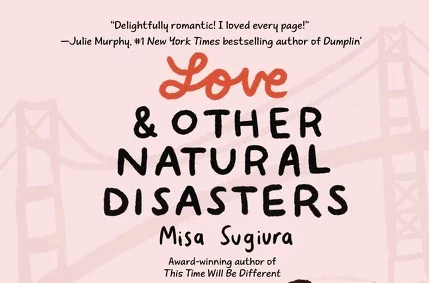There’s so much to admire in Misa Sugiura’s writing. The way she beautifully and honestly captures the angst and joy of navigating life as a teenager. Her courage in tackling complicated social injustices. Her sensitive representations, whether of cultural, racial, gender or sexual identity. I’m in awe of all the layers she blends into her stories, while still keeping them relatable and even humorous for her teen readers. It’s been a deep pleasure getting to know Misa within the writing community and also through her gorgeous stories. Misa Sugiura’s Love and Other Natural Disasters came out in paperback on June 7th, 2022. ~ Kristi
KidLit Craft: In your latest novel, Love and Other Natural Disasters, you really nail all the beats of a rom-com structure. Did you immerse yourself in rom-com movies and books before you attempted it? Now that you’ve accomplished it, what do you think is critical to pulling off a strong rom-com?
Misa Sugiura: I did immerse myself in rom-coms! (Mostly movies, though, because they’re faster than books.) I borrowed some old classics from the library: Bringing Up Baby, It Happened One Night, and His Girl Friday–and watched pretty much the entire Netflix rom-com menu. I read or listened to a lot of Sophie Kinsella novels, as well. More than anything, I was trying to soak up the rom-com voice and vibe I wanted, which is a slightly zany, blithe optimism that masks deep insecurity. (My other favorite voice is sharply intelligent, self-deprecating humor that clearly expresses deep insecurity.) Another important component: the protagonist has to make a terrible decision and commit to it despite clear evidence that she has made a mistake. I think this might be the toughest part, because the decision and its consequences have to be over the top, but still funny and believable.
KLC: In a recent LitCelebrAsian interview, you mentioned that your editor broke down the key elements of the fake dating trope for you. What were your biggest takeaways about that trope?
MS: I was very lucky to have Stephanie Stein as my editor because she really knows her genres. The thing I was missing in my early drafts was the crucial element of what she called “pining.” Because the beauty of the fake relationship is in the layers of pretense, and the irony comes from the protagonist having to pretend not to be in love with the person whom they are pretending to be in love with (if that makes sense!). The pain of having to keep their real feelings secret—at the same time that they are literally making them public.
KLC: You tap into teen angst so well. Do you have any go-to techniques for getting yourself into the proper headspace for your characters?
MS: For me, knowing the character–having a sense of what pushes their buttons, who and what they fear, love, hate, etc.—is key to being able to write them in a way that’s compelling and believable. I write pages and pages of notes on my main character before I write even a sentence of my first draft. As for the angsty part, once I know my character, it’s easy to “become” them when I write, and teenagery feelings kind of flow out. If you’re having trouble accessing those feelings even after you’ve worked on your character, I think journaling about your own life can help lift that last veil–just write about the most humiliating or exhilarating moments of your teenage years, striving for unfiltered vulnerability and emotion. Alternatively, read your old journals, if you kept them. It can be a humiliating experience, but boy will it bring those emotions rushing back!
KLC: Your teen characters not only must navigate their own relationship crises, but they also deal with broader problems, like historical injustices, adultery, divorce, etc. Do you have any advice for how to craft books with multiple layers?
MS: I think building your book around a central theme is useful for this. I create my characters’ flaws, misconceptions, and spiritual wounds around a theme or a question that interests me, and then I give them a personal conflict that directly challenges those flaws, misconceptions, and wounds. After that, it’s a matter of developing broader challenges, events, relationships, and conflicts that can revolve around the same theme. For example, in my second book, This Time Will Be Different, I wanted to explore how we move forward from injustices and mistakes from the past. So I gave CJ the flaw of being someone who can’t let go of a grudge, and I made her face layers of problems and relationships that challenge her grudges and her issues with the past. Some are sort of small and petty, like how she hates her best friend’s crush because of something the crush did five years earlier; some are deeply personal, like a mistake she herself made a year ago that exacerbated a source of pain in her relationship with her mom; and some are broader social issues, like the Japanese American internment and how it’s affected her family and her community. When you do it this way, you can transition between a range of problems and relationships, and it feels organic because of their common theme and their connection to the protagonist’s defining characteristics.
KLC: How has craft study informed your writing?
MS: So many ways! I like to say that I got my MFA from Google University because I Googled “how to . . .” for nearly every aspect of my first novel. I learned how to write a scene (every scene has to have its own arc); tips for writing dialogue (start as close to the middle as you can; make sure each character has their own goals throughout the dialogue); tips for writing setting (try to describe it in a way that reflects the character’s inner state); how to pace a novel using beat sheets (my favorite is Save the Cat). I think the most important thing I learned was how to build a character by identifying their desires, needs, fears, and mistaken beliefs.
KLC: How has being published changed your writing practice/writing process?
MS: I decided to treat writing as a serious practice when I first started, so that hasn’t changed too much–it’s butt in chair for three or four hours a day. But I feel a lot more pressure to produce now. I also spend more time working on the bones of my character and their motivations before I begin writing, because I don’t have the luxury of doing a leisurely re-read and revision a quarter of the way and halfway through, the way I did before I was published.
KLC: What do you feel you’ve gained from being a part of the KidLit community?
MS: So many things: friends, teachers, perspective. It’s great to have friends who really understand what you do as a writer. And this might be shallow, but it’s so cool to walk into a bookstore and look at all the books and think, “I know the person who wrote that book. And that one, and that one, and that one . . .”
KLC: What can Misa Sugiura fans look forward to next?
MS: The first book of my middle-grade fantasy series is coming out next year! It’s called Momo Aarashima Steals the Sword of the Wind, and it’s about a girl who discovers that her mother is a banished Shinto goddess who guards a secret island portal between this world and the land of the dead. The island has recently come under attack by the demon king; if Momo doesn’t stop him, her mother will die, the portal will open, and an army of demons and monsters will stream through and wreak havoc on Earth. Joined by Niko, a talking fox, and Danny, her former-best-friend-now-enemy, Momo has to track down an ancient magic sword and learn to use it in order to defeat the most powerful demon in the world. I had a blast writing it, and I hope that readers will love it as much as I do!
For more great craft discussions, check out our interviews with Stacey Lee and Rita Williams-Garcia.
Kristi Wright (co-editor) writes picture books and middle grade novels. Her goal as a writer is to give children a sense of wonder, a hopefulness about humanity, and a belief in their future. She is represented by Kurestin Armada at Root Literary. She is an active volunteer for SCBWI and a 12 X 12 member. Find her at www.kristiwrightauthor.com and on Twitter @KristiWrite.




COMMENTs:
0